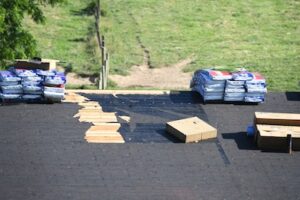How to Prepare My Roof For Tornado Season?
With tornado season upon us, now is the time to take action and make sure your roof is prepared for any potential extreme weather events. So if you are wondering, how to prepare my roof for tornado season?
There are several ways that you can get your roof ready for severe weather and make sure it is equipped to withstand a storm’s strong winds and possible debris including:
- Checking Roof Shingles and Materials
- Inspect the Flashings and Sealants
- Trim Tree Branches Close to Roof
- Clean and Clear Gutters
- Check Roof Vents
So, now that you have an idea of some of the steps to take, let’s examine in greater detail how to prepare your roof for these turbulent months ahead so that you can rest easy knowing that you and your property are safe.

Steps to Prepare Your Roof for Tornado Season
It is important to prepare your roof in advance of tornado season. Taking precautions now can prevent damage and potential roof failure during high winds. Below are some steps you can take to make sure your roof is ready for tornado season:
1. Check Roof Shingles/Materials
Check the condition of the roof shingles or other roofing materials for any signs of wear, such as curling, cracking, or loose fasteners. If there are any existing problems, replace damaged materials with approved roofing products that comply with local building codes and regulations.
2. Inspect the Flashings and Sealants
Inspect the roof’s flashings and sealants for any gaps or cracks that could allow wind-driven rain into your home. Make sure all nail heads are properly sealed with roof cement and any roof penetrations, like plumbing vents or skylights, are properly flashed.
3. Trim Tree Branches Close to Roof
Trim back any overhanging tree branches that could hit the roof during a storm and cause damage to roofing materials or allow water to enter your home. Additionally, inspect the roof for any buildup of dead leaves and twigs that can block drainage channels in the roofing system and cause water to pool on the roof.
4. Clean and Clear Gutters
Make sure all gutters are free from debris and clear of blockages so they can effectively move the rainwater away from your home’s foundation. Clear out all downspouts as well, ensuring they have at least one foot of vertical clearance from the ground below.
5. Check Roof Vents
Make sure any roof vents are in good working condition and that their screens are free of dirt and leaves. Additionally, check the roof for any openings around plumbing vents or other roof penetrations where wind-driven rain can enter your home.
By taking these steps now, you can help protect your roof from potential damage during tornado season. If you ever have questions about how to prepare your roof for tornado season, consult a professional roofing contractor who can provide expert advice on what precautions to take.

When Is Tornado Season?
Tornado season typically begins in the spring and ends in early summer. In the United States, tornado season usually runs from March through June. During this time, tornado threats increase due to stronger and more frequent thunderstorms. Tornadoes can occur at any time of the year, but they are most likely to form during tornado season when conditions are favorable for their development.
The peak tornado season varies by region, with tornado activity highest in the southern Plains states of Texas, Oklahoma, Kansas, and Nebraska. The Gulf Coast states also experience a significant amount of tornado activity during tornado season as warm humid air from the Gulf of Mexico collides with cold dry air from Canada or western regions of the country.
It’s important to be aware of tornado season and to take the necessary precautions when tornado warnings are issued. Having a tornado plan in place and knowing what to do if a tornado strikes your area can help keep you safe during tornado season. Staying informed about severe weather alerts, having an emergency kit on hand, and keeping up with tornado safety tips are all important steps to staying ahead of tornado threats. With proper planning and preparation, individuals can ensure they stay safe during tornado season.
Should I Get My Roof Inspected Before and After a Tornado?
It is important to get a roof inspection both before and after a tornado. Tornadoes can cause extreme damage to roofing materials, as they are often subjected to high winds, flying debris, and other hazardous conditions. During an inspection, a roofer will check for loose or damaged shingles and tiles, roof flashing problems, roof penetrations such as vents and skylights, roof decking issues due to water damage or erosion, the condition of the underlying roof structure, and any other potential hazards.
Then after a tornado has passed through your area it is important to inspect your roof for additional damages that may have occurred. As a professional should be able to determine if there are any areas of damage on your roof that was caused by the tornado. If roof repairs are needed it is important to make sure they are completed in a timely manner to avoid further roof damage or leaks inside your home.
In conclusion, it is critical to get a roof inspection both before and after a tornado passes through your area. A professional roofer can assess any potential damage and make necessary repairs quickly, helping to protect your home from further damage and keeping you safe.
Do You Have to Replace Your Roof After a Tornado?
It is possible that you may need to replace your roof after a tornado. Depending on the severity of the storm, roof damage can range from minor cosmetic issues to extensive structural damage. If there has been an extreme amount of roof damage, then it’s likely that replacement will be necessary.
This is why it is important to inspect your roof after a tornado and assess the extent of the damage. Look for signs such as missing roofing materials, cracked tiles or shingles, dented flashing, evidence of water intrusion, and other indications of roof damage. If any of these are present, you should contact a roofing expert who can properly evaluate your roof and advise you if replacement is required.
At the end of the day, it’s important to understand that roof damage caused by a tornado may require roof replacement. So while replacing your roof after a tornado may seem like an overwhelming task, it’s important. As this will ensure your roof is safe and secure. Taking the necessary steps to replace your roof after a tornado can help you avoid costly repairs in the future. If you have any questions or concerns, be sure to contact a roofing professional for expert advice.

Conclusion
Remember that it is essential to take preventative measures and make improvements that can help protect your roof from tornadoes. Regular maintenance such as trimming tree branches near your roof, installing gutter guards, inspecting and sealing roof flashing, and inspecting your roof for signs of damage can all help ensure that your roof will remain strong and durable in case of a tornado. Taking these proactive steps can go a long way toward preventing major roof damage during storms like tornadoes.
Related Questions
Are roof inspections expensive?
Roof inspections can be costly, depending on the roof’s condition and complexity of the roof. If a roof inspection is needed to repair or maintain an existing roof, it can be costly due to labor costs for roofers and materials. On the other hand, if the roof only needs minor repairs or maintenance, then a roof inspection will not be as expensive.
Where to go in case of a tornado?
The best place to go is an underground shelter or basement. If neither of these options is available, look for a small interior room on the lowest level such as a closet, bathroom, hallway, or stairwell away from any windows. If time allows, bring blankets and pillows to help protect yourself from flying debris. Get under something sturdy like a heavy table or desk and stay away from windows until the storm passes.
Should I board up my house if there is a tornado?
Boarding up your house is a way to protect your home from damage in the event of a tornado. While it is possible to board up your windows and doors yourself, it is best to use professional services. Boarding up can help keep your home safe during severe winds and help reduce potential damage. However, boarding up may not be enough protection in extreme cases, such as when a tornado has been classified as an EF-3 or higher. As additional measures may need to be taken for safety.
